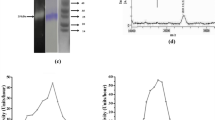Summary
A protease extract from Antarctic krill (E. superba) intended as a new enzymatic debrider for necrotic ulcers has been characterized by sodium dodecyl sulphate polyacrylamide gradient gel electrophoresis and fast protein liquid chromatography. The predominant enzymes in the preparation represent trypsin-like activity associated with three serine proteinases. In addition two carboxypeptidases A and B are present as cooperative enzymes for a more complete breakdown of complex proteinaceous substrates. Biological studies on a well-defined substrate (fibrin) originating from leg ulcers, demonstrated more effective degradation by krill enzymes than bovine trypsin, a common component in marketed enzymatic debriders. These findings support previously in vitro/in vivo studies in an animal model (rat) using excised rat skin as “necrotic” tissue.
Similar content being viewed by others
Abbreviations
- TAME:
-
p-toluene-sulfonyl-l-arginine methyl ester; hipp-l-phe hippuryl-l-phenylalanine; hipp-l-arg, hippuryl-l-arginine
- Cpase:
-
carboxypeptidase
- SDS:
-
sodium dodecyl sulphate
References
Bucht A, Karlstam B (1986) Immunological characterization of three highly purified trypsin-like enzymes from Antarctic krill (Euphasia superba). Biol Chem Hoppe-Seyler [Suppl] 367:366
Bucht A, Johansson B, Karlstam B (1986) Separation and identification of proteases from Antarctic krill (Euphausia superba). 6th Int Symp HPLC Proteins, Peptides and Polynucleotides, Baden-Baden, pp 34
Campbell D, Hellgren L, Karlstam B, Vincent J (1987) Debriding ability of a novel multi-enzyme preparation isolated from Antarctic krill (Euphausia superba). Experientia 43:578–579
Falanga V, Eaglstein WH (1986) A therapeutic approach to venous ulcers. J Am Acad Dermatol 14:777–784
Folk JE, Schirmer EW (1963) The porcine pancreatic carboxypeptidase A system. J Biol Chem 238:3884–3894
Folk JE, Piez KA, Carroll WR, Gladner JA (1960) Carboxypeptidase B: purification and characterization of the porcine enzyme. J Biol Chem 235:2272–2277
Hellgren L, Mohr V, Vincent J (1986) Proteases of Antarctic krill — a new system for effective enzyme debridement of necrotic ulcerations. Experientia 42:403–404
Hellgren L, Mohr V, Vincent J (1987) Krill enzymes — a new debrider for necrotic ulcers. 17th World Congress of Dermatology, Berlin, pp 196
Johansson B, Karlstam B (1986) Purification and identification of carboxypeptidase A and B from Antarctic krill (Euphausia superba). Biol Chem Hoppe-Seyler [Suppl] 367:366
Kunitz MJ (1947) Crystalline soybean trypsin inhibitor. Gen Physiol 30:291–309
Lowry OH, Rosebrough NJ, Farr AL, Randall RJ (1951) Protein measurement with the Folin phenol reagent. J Biol Chem 193:265–275
Osnes KK (1985) Peptide hydrolases of Antarctic krill (Euphausia superba). Thesis, Norwegian Institute of Technology, Trondheim
Rick W (1974) In: Bergmeyer HU (ed) Methods of enzymatic analysis, vol II, 2nd edn. Academic Press, New York, pp 1013–1023
Author information
Authors and Affiliations
Rights and permissions
About this article
Cite this article
Anheller, J.E., Hellgren, L., Karlstam, B. et al. Biochemical and biological profile of a new enzyme preparation from antarctic krill (E. superba) suitable for debridement of ulcerative lesions. Arch Dermatol Res 281, 105–110 (1989). https://doi.org/10.1007/BF00426587
Received:
Issue Date:
DOI: https://doi.org/10.1007/BF00426587




